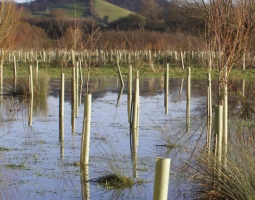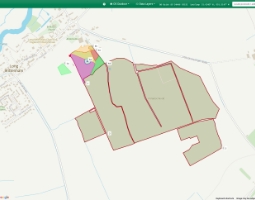Precipitation Projections
Precipitation projections show how future rainfall patterns may shift with the changing climate. Changes in precipitation patterns are likely to alter soil water availability, affecting the growth of trees and other vegetation and the overall functioning, productivity and health of woodlands and forests.
By understanding these changes, we can begin to develop and improve strategies to mitigate their impacts. This page provides precipitation projections up to 2080 for the UK.
Projected percentage change (%) in UK growing season precipitation (April – September) from 2000 to 2080 over 4 distinct periods for the RCP 8.5 scenario when compared to the baseline (1980-2000) – Forest Research, 2025
Growing season precipitation (April – September)
Growing season precipitation projections indicate a high probability of drier conditions, with decreases of up to 60% (~200 mm) in total precipitation across the UK, particularly in southern England, for the 2060-2080 period. The data also suggests that the likelihood of individual wet summers will only reduce slightly. This means that while summers are expected to become generally drier, occasional wet summers will still happen, but less frequently (UKCP18 Factsheet: Precipitation, 2019).
Projected percentage change (%) in UK non-growing season precipitation (October – March) from 2000 to 2080 over 4 distinct periods for the RCP 8.5 scenario when compared to the baseline (1980-2000) – Forest Research, 2025
Non-growing season precipitation (October – March)
Recent observations have shown substantial year-to-year variability in non-growing season precipitation, with a slight overall increase in recent years. The data projects an increase of up to 30% (~450 mm) in total precipitation across some coastal areas and southern and central England in the UK during the 2060-2080 period when compared to the baseline under RCP8.5. However, due to the variability of the UK climate, dry and cold winters will still occur (Climate change in the UK – Met Office).
What risks do changes in precipitation pose to forests?
Precipitation changes are likely to cause substantial impacts to forests and woodlands. Prolonged and excessive periods of rainfall can cause surface and river flooding, which can saturate soils and reduce the oxygen availability to tree roots. The persistent waterlogging can physically and structurally weaken trees, making them prone to pest and disease attacks as well as windthrow, especially during storms. Excessive rainfall can also wash out plant nutrients from the soil and remove soil organic matter.
Conversely, long periods of low rainfall, especially when combined with higher temperatures, can result in drought conditions. Drought reduces the water available to trees, stressing them and other vegetation, reducing growth and potentially affecting survival. These extremes in precipitation pose significant challenges for tree health and forest management, requiring adaptive strategies to mitigate these impacts.




